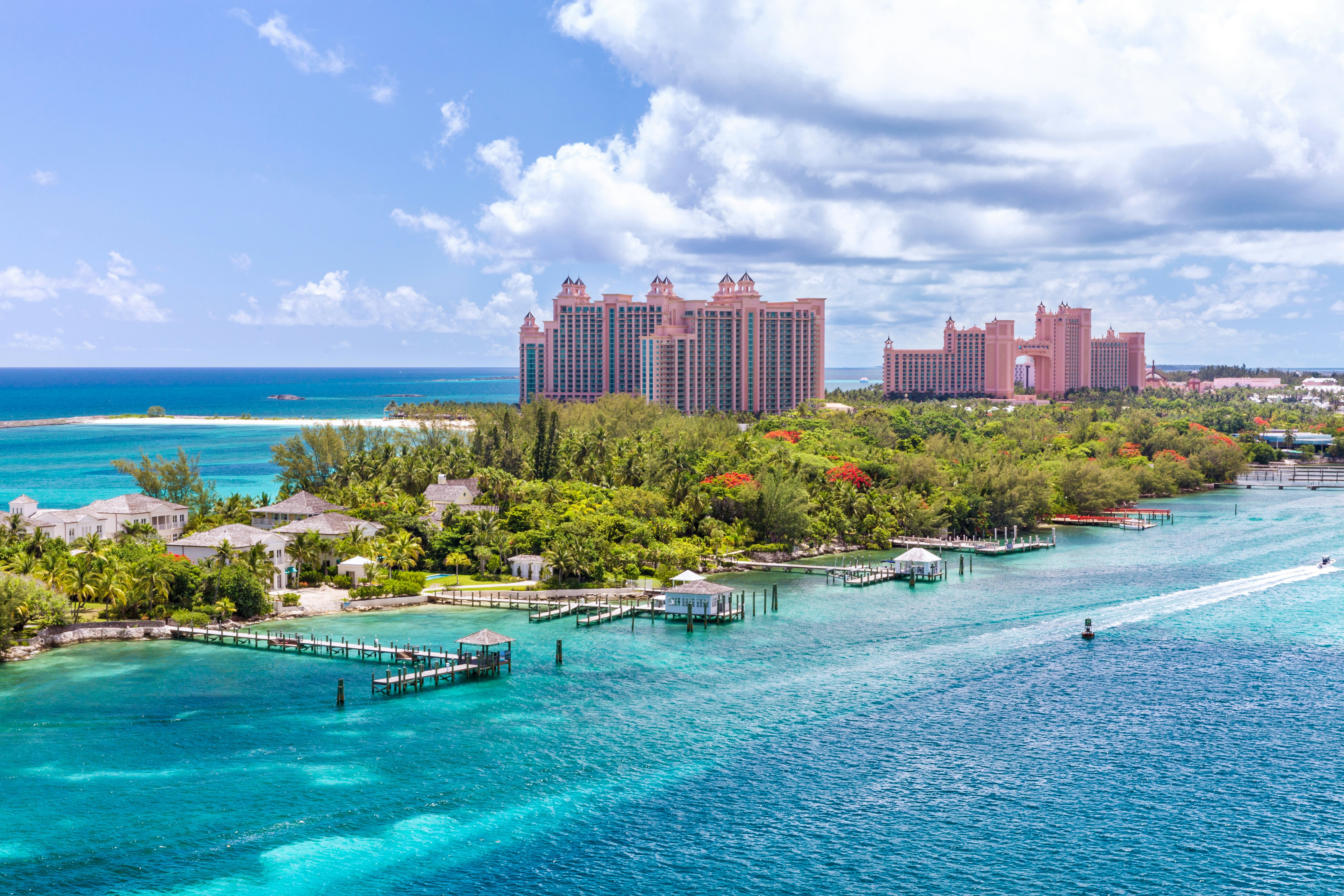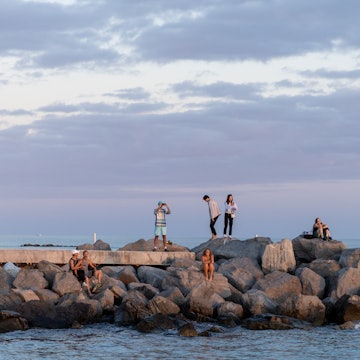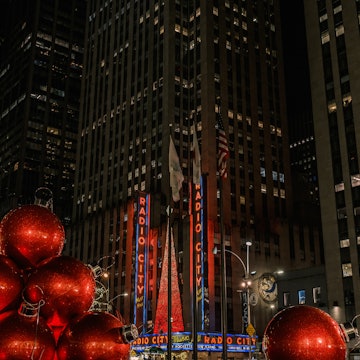

Local villas at Nassau Harbour. Wangkun Jia/Shutterstock
The Bahamas, an archipelago of 700 islands and cays (though only 30 are inhabited), is celebrated for its dazzling turquoise and pink waters, pristine beaches and balmy weather.
Yet, this island nation offers more than just picturesque scenery – it's a vibrant mosaic of culture and history. From the rhythmic beats of Junkanoo to the mouthwatering flavors of fresh conch and sweet guava duff, The Bahamas transforms every visit into a lively adventure.
Whether you want to dive into blue holes, sail across sparkling seas or revel in local parades, each island invites you to immerse yourself in the rich tapestry of Bahamian life. Our first-timer's guide has everything you need to know before you go.
When should I go to The Bahamas?
The Bahamas is a popular year-round destination, but timing your visit can greatly enhance your experience. Peak season runs from December to April, offering sunny days and pleasant temperatures. However, this period also brings bustling crowds and the highest accommodation and airline prices.
For a more dynamic summer experience, visit from April to August when the islands come alive with annual cultural festivals like The Bahamas Carnival in May, the Pineapple Festival in June in Eleuthera's Gregory Town and the Exuma Regatta in late April or early May.
The summer kicks into full gear with the Goombay Summer Festivals in July and August in Nassau, Grand Bahama and other islands, featuring Junkanoo rush-outs (small parades), "rake 'n' scrape" bands and dance performances.
The shoulder seasons of May and September to November are ideal for fewer crowds and lower prices. Remember that hurricane season runs from June to November; checking weather forecasts and considering travel insurance is advisable.

How much time should I spend in The Bahamas?
Ideally, at least four days will allow you to fully experience the Bahamas, especially if you want to explore beyond Nassau and visit other islands.
For a shorter trip, two to three days will give you time to explore Nassau's highlights. Visit the Pirates of Nassau Museum and Atlantis Resort on Paradise Island, where you can try your luck at the casino or explore the marine habitats. Love Beach (USD$5 entry fee) is perfect for a quiet beach day and an undisturbed snorkeling experience.
For dining, head to the shacks at Arawak Cay, known as "Fish Fry," on West Bay Street, to savor the best conch fritters, cracked conch, grilled fish, and Bahamian peas and rice. If time permits, catch the flamingo show at Ardastra Gardens.
With a four-day stay, you can venture beyond Nassau. Take a day trip to Exuma to swim with the famous pigs at Pig Beach (more on that below) or explore the underwater caves at Lucayan National Park on Grand Bahama. You'll also have time to visit less-touristy islands such as Harbour Island, renowned for its Pink Sand Beach.
Is it easy to get in and around The Bahamas?
Getting to The Bahamas is straightforward, particularly for travelers from North America. The main gateway is Lynden Pindling International Airport (NAS) in Nassau, with direct flights from major cities such as Miami, New York, Atlanta and Toronto. European travelers can find direct flights from London, with connections available through US hubs.
Once in Nassau, travel within The Bahamas is convenient. Bahamasair provides daily flights from Nassau to many Out Islands, including Exuma, Eleuthera and Governor's Harbour. The Bahamas Fast Ferries service also offers scenic trips between Nassau and several Out Islands, such as Harbour Island and Eleuthera.
For short island trips, take a water taxi, like the $6, 10-minute ride from Prince George Wharf (New Providence) to Paradise Island. Car rentals cost around $55 to $120 daily, and driving is on the left. In Nassau, public buses (called jitneys) cost $1.50 per ride and operate until around 7pm.
Taxis start at around $7 (rates are for two people). From downtown Nassau to Paradise Island, the fare is $9 plus a $2 toll, and from the airport to downtown Nassau, it's $32.
For smaller settlements like the cays of Little Exuma and Spanish Wells off the coast of North Eleuthera, transportation is typically by golf cart, scooter, bicycle (all available for rent) or on foot.

Top things to do in The Bahamas
Explore the Exuma Cays
The Exuma Cays are famous for their unique inhabitants – swimming pigs. Big Major Cay, often called Pig Beach, is where you can see these charming creatures frolicking in the crystal-clear waters.
However, there are some considerations to keep in mind. The water around Pig Beach may appear pristine, but it can be less appealing because of how much time the pigs actually spend in it. This can lead to murky conditions, which some visitors find offputting.
Additionally, while the pigs are generally friendly, they can become aggressive, especially when food is involved. Visitors have been warned not to hand-feed the pigs – use skewers instead – and to be cautious about the pigs stepping on their feet, which can be painful.
A visit typically includes a boat tour that allows you to interact with the pigs, but it's important to remain responsible when it comes to their welfare. Excursions often include stops at other stunning locations, like Thunderball Grotto, a picturesque underwater cave system perfect for snorkeling enthusiasts. Tours to Pig Beach cost around $200.
Relax on Blue Lagoon Island
Just a short boat ride from Nassau, Blue Lagoon Island is a private paradise that offers a peaceful escape from the city. The island's pristine beaches and calm lagoons are perfect for relaxation, but there are also plenty of activities for those seeking adventure.
You can join the "sip & paint" program and enjoy a creative session with a drink in hand on the beach, or go on an eco-adventure tour with guides who share stories about the island's folklore, native foods, plants, birds and marine life.
For water enthusiasts, the island offers paddleboard, kayak and clear-bottom kayak rentals, as well as snorkeling opportunities to explore vibrant coral reefs. Families with kids will also enjoy free access to the aqua and tropical paradise bounce inflatable parks.
A typical beach day package at Blue Lagoon Island costs $85, while the eco-adventure tour package costs $114.

Visit Pink Sands Beach on Harbour Island
Relax on Pink Sands Beach on Harbour Island, where the unique pink-hued sand and gentle, shallow waters are perfect for swimming, paddleboarding and kayaking.
For fishing enthusiasts, the island is a prime spot for bonefishing, with guided tours to explore the rich flats. Snorkeling trips offer access to vibrant coral reefs and marine life around nearby sites like Devil's Backbone.

Experience Junkanoo parades
Junkanoo is a Bahamian festival celebrated in Nassau on Boxing Day (December 26) and New Year's Day (January 1). It also takes place in other islands and communities across the Bahamas, such as Grand Bahama and Eleuthera.
In Nassau, the celebrations center around Bay Street, where exuberant parades, colorful costumes and lively music bring the streets to life.
Distinct from the Bahamas Carnival, Junkanoo features groups called "rake 'n' scrape" bands, which play traditional rhythms using an accordion, a goat skin drum and a handsaw that's scraped with a knife, nail or screwdriver. Revelers in elaborate costumes dance through the streets.

Explore Atlantis Resort on Paradise Island
For a day pass starting at $75, you can explore the Atlantis Resort's famous facilities, including Aquaventure, one of the largest waterparks in the world, and the largest open-air marine habitat, featuring over 250 marine species.
Even without a pass, you can visit the Atlantis Casino, shop at the Crystal Court Shoppes with a range of luxury boutiques, and dine at various restaurants.
My favorite thing to do in The Bahamas
One of my favorite experiences in The Bahamas is diving into the exhilarating Bahamas Carnival held every May. This vibrant festival transforms the streets into a dazzling spectacle of music, dance and flamboyant costumes that burst with color and creativity.
The air is electric with pulsating soca rhythms, and the energy of the crowd is contagious as dancers in elaborate costumes parade through the streets, celebrating with infectious joy.
What makes Bahamas Carnival truly unforgettable is its unique blend of local traditions and the broader Caribbean carnival spirit. While carnivals across the region share parades, soca music and an atmosphere of exuberance, each country infuses its own flavor into the festivities.
In The Bahamas, the influence of Junkanoo is unmistakable. You’ll see its distinctive costumes, crafted from vibrant fabrics and intricate beadwork, and hear the rhythmic beats of drums that are a hallmark of Bahamian culture. This rich fusion of Junkanoo with soca and calypso creates a one-of-a-kind carnival experience that stands out from those in Trinidad, Barbados or Jamaica.
The result is a celebration that is both deeply rooted in Bahamian heritage and wonderfully aligned with the vibrant Caribbean carnival tradition.
How much money do I need for The Bahamas?
The Bahamas caters to various budgets. Note that the Bahamian dollar (BSD) is on par with the US dollar (USD).
Hostel/budget accommodation: BSD$70-150
Mid-range hotel: BSD$200-350
High-end resort: BSD$400+
Meal at a local restaurant: BSD$15-30
Three-course meal for two at a mid-range restaurant: BSD$80-150
Beer at a bar: BSD$4.50+
Conch salad: BSD$12-15
Public bus ticket: BSD$1.50
How many islands in The Bahamas can I travel to?
About 30 Bahamian islands are inhabited, with 16 considered major islands. Popular ones include New Providence (Nassau), Grand Bahama and Abaco. Islands like Nassau, Grand Bahama, Exuma and Eleuthera are easily accessible by daily domestic flights and ferries. Remote spots like Long Island, Harbour Island and Bimini require extra time and planning.

What are some Bahamian foods that I should try?
Try conch, the unofficial national dish found in nearly every restaurant. It's served in many ways, but a few of my favorites are the conch salad – a ceviche-like mix of diced raw conch with veggies and citrus; cracked conch – battered and fried to golden perfection; and conch fritters – deep-fried bites with a tangy dipping sauce.
For dessert, try guava duff – a traditional Bahamian treat made with guava and topped with a rich rum or vanilla sauce.
Can I spend my USD in The Bahamas?
Yes, you can use US dollars in The Bahamas without exchanging them. The Bahamian dollar (BSD) is pegged 1:1 with the USD, so both are accepted. Still, carrying some Bahamian dollars is wise, especially for smaller transactions or in remote areas.














